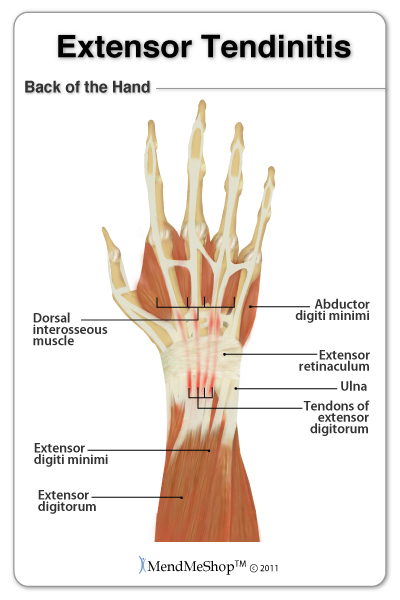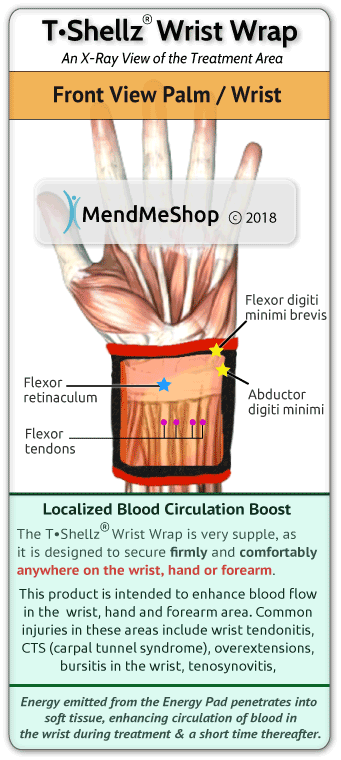Tendons are vital structures connecting muscles to bones. In the top of the wrist and back of our hands, there are a set of tendons, called extensor tendons, which are responsible for the fine dexterous movements of the hand. They are made up of tissue called collagen and elastin, ensuring that the tendon is both tough but flexible.
Tendons need to glide smoothly, allowing the powerful contraction of the muscle to move the intended bones and joints, and hence are enclosed by synovium, a thin sheath of smooth tissue. When the tendons become irritated, their ability to glide within these compartments is restricted, causing wrist and hand pain during movement and tenderness when direct pressure is applied.
Tendon fibers can tear apart in the much the same way a rope becomes frayed. Once a tendon becomes frayed, an inflammatory response is triggered; over time an inflamed tendon can become thick, bumpy and irregular making it more difficult to glide during hand movements. Without proper rest and time to heal, a damaged tendon can become permanently weakened.

Extensor tendons connect muscles in the forearm to the finger bones at the top of the wrist over the back of the hands. The muscles pull on the tendons which cause the hand and fingers to extend. The tendons run through a series of rings, or pulleys, that form tunnels along the fingers and thumb. They work similar to a line guided along a fishing rod, with the pulleys holding the tendon close to the bone. These tendons are made up of tissue called collagen and elastin, ensuring that they are both tough and flexible.
Extensor tendons need to glide smoothly and are enclosed by synovium - a thin sheath of smooth tissue that reduces friction for easier movement. When the tendons become irritated and inflamed, their ability to glide within these compartments is restricted. This causes wrist and hand pain during movement and tenderness when direct pressure is applied. When the extensor tendons are inflamed it is referred to as extensor tendinitis, also spelled tendonitis.
An injury to these tendons can make everyday tasks difficult, and may very well affect a persons performance or abilities at work. At present the results of tendon repair surgery are far from ideal, as such an invasive technique can often create excess scar tissue (adhesions) between the sheath and the tendon, restricting mobility and leading to a loss of function.
Traumatic disruptions of the extensor tendons or sheath can be very serious, and very often will require tendon repair surgery. An injury to this tendon can easily make everyday tasks difficult, and may very well affect a persons performance or abilities at work. At present the results of tendon repair surgery are far from ideal, as such an invasive technique can often create excess scar tissue (adhesions) between the sheath and the tendon, restricting mobility and leading to a loss of function.
If tendons are stressed enough from excessive or unconditioned use, the sheath lining can become inflamed and movements may be painful to varying degrees as the tendons glide through the inflamed sheath. Tendinitis can be caused from overuse of a limb during an activity. For example, if a person undertakes a massive spring cleaning, the wrist is usually held in a hyper-extended position as the palm exerts the pressure. The extensor tendons at the wrist level are strained and tendon sheaths become inflamed. In contrast, planting a winter garden may involve more forceful wrist flexion as small spades are repeatedly drawn toward the body. This strains the wrist flexor tendons which may become painful with wrist motion, tender to direct pressure and possibly swollen.

Prevention of extensor tendinitis is exercised simply by not overdoing any activities that use a lot of wrist motion. (ie. cleaning, gardening, typing, filing and writing) Be careful about suddenly increasing the time spent on these activities, as your tendons are not properly conditioned to the added stress. Close attention also should be paid to the positioning of the wrist and hand - try to maintain the wrist in a neutral position and avoid any excessive flexing (bending the wrist forward) and extending (bending of the wrist backward).
If you have tendinitis in your hand or wrist, rest is highly recommended. Avoid activities that cause pain or may have caused the inflammation and begin cold compression treatments as soon as possible.
During the healing process, scar tissue builds on the damaged tendons; this scar tissue can cause the tendon to thicken, decreasing the area in tight spaces (such as the wrist), increasing the chance of nerve impingement. Nerve impingement in the wrist is basically what Carpal Tunnel Syndrome describes.
In addition, know that scar tissue attaches to everything. It can bind tendons, ligaments, muscles, bone and even skin together wherever it grows. Inflexible scar tissue will limit movement of your soft tissue very quickly. Tendons and muscles that were once elastic are now constrained - if you stretch it too far it will start to rip, causing spikes of pain. As a result, movement of the entire joint is limited, making it difficult to flex your hand and/or wrist or even grasp objects. At the very least, scar tissue leaves a tendon weaker than a healthy tendon, leaving injury at greater risk of further deterioration and possible tearing.
The trick to any tendon injury is getting it to heal with minimal scar tissue formation and with as much realignment of tendon fibers as possible. To achieve this, your doctor will most likely recommend up to 6 months of conservative treatments. Even with optimum healing there is always less elasticity in a previously injured tendon. The trick is to make sure you heal it the best you can, that way your chance of re-injury down the road is much lower than average - which is well over 50%.
Once the inflammation of your tendinitis has been reduced through use of a Cold Compress or Ice Pack, nourishing and strengthening of the hand/wrist tendons, muscles and surrounding area is recommended - this includes our recommendation of stretching and home treatments using the Wrist TShellz Wrap®. Talk to your doctor or physical therapist to find out which exercises are appropriate for your situation.
The Wrist TShellz Wrap® may be used after the acute swelling has improved; the TShellz Wrap® will stimulate blood flow in the local area, while also warming up the tissue. It is known that warmed tissue will experience a larger range of motion and increased extensibility and this is exactly what you want when you are trying to recover from a soft tissue injury. Increased extensibility and flexibilty in soft tissue means it is less likely to strain or tear further during activity, and less re-injury during your recovery means your recovery will be much faster. A faster recovery minimizes the build up of scar tissue around the tendon during the healing process, while also reducing the risk and severity of overcompensation pain and secondary injuries. Basically, the value of a faster recovery is often underestimated, as the impact of chronic injuries can quickly spiral out of control.
Often when a tendon injury occurs, the injured area is rested a bit, a pain killer is taken and we continue on with our normal activities. If the strain was minor, the body may be able to heal the tendon fibers normally. Unfortunately, this is not the usual result because the injured tendon is being used instead of rested. Because of the stress on the tendon, the body heals the injured fibers by binding them together with fibrotic adhesions or scar tissue. This is done in an attempt to prevent further damage to the injured area. It is a normal protective response of the body, but buildup of scar tissue can and does become a big problem over the long term.
Scar tissue buildup is one of the main reasons we advocate the use of a TShellz Wrap® over the long term once the swelling is down. Much of the pain may have disappeared with the swelling, but that does not mean your tendonitis has healed. The trick is to continue boosting blood flow to the area on a daily basis, helping keep tissues in the area flexible and less likely to strain while your tendon(s) continue to build up strength.

We all know that if the injury was healed, the pain would go away but what about the opposite situation? If the pain is gone, does that mean the injury is better? Unfortunately, this is not always true.
Too many people only focus on suppressing pain symptoms while providing less attention to the true healing aspects of the body. Experiencing less pain, while obviously a good short-term goal, does not equate to underlying healing. Scar tissue can remain for months after one gets to a point of being relatively pain-free. However, as long the weak and brittle scar tissue remains, you are susceptible to re-injury or re-aggravation. Certain motions or movements can cause the weaker tissue to easily tear - resulting in some reversal of the recovery up until that point.
This is why we recommend for people to continue with their doctor or therapist recommended exercises and to continue with mild treatments of the TShellz Wrap® for a period of time - to better ensure complete recovery.
Ongoing treatments to enhance circulation are intended to soothe, relax and promote healing of damaged soft tissue in the application area. T•Shellz treatment also results in the ability of soft tissue to extend further due to the effect of heat on soft tissue. The more extensible your tissues are, the less likely they are to strain or sprain.
People tell us all the time, "I was told that if I stay off my feet for a few weeks, my pain will disappear for good."
The truth is, tendonitis pain is usually a culmination of numerous factors, such as repetitive stress, poor posture, acute injuries, and overcompensation issues resulting from other muscle and soft tissue ailments.
It may take weeks or months for these pain triggers to surface. When they , however, merely resting will solve the underlying issues. You need to utilize actions and options that actually treat the source of the pain and help reverse the damage that has been done.
Resting has a role to play, but it is only one small factor in a recovery plan.
Product Advisors are available 9:00 am to 5:00 pm Eastern Standard Time Monday to Friday.
I want to learn more about Post-Surgery Recovery
I want to learn more about TShellz Wrap® Circulatory Boost
I want to learn more about Ice & Heat: Which Is Better For Treatment?
I want to learn more about Tendonitis Treatments
I want to learn more about Tendonitis Surgery
During your recovery, you will probably have to modify and/or eliminate any activities that cause pain or discomfort at the location of your soft tissue injury until the pain and inflammation settle. The more diligent you are with your treatment and rehabilitation, the faster you will see successful results!
Please be aware that this information is neither intended nor implied to be a substitute for professional medical advice. CALL YOUR HEALTHCARE PROVIDER IMMEDIATELY IF YOU THINK YOU MAY HAVE A MEDICAL EMERGENCY. Always seek the advice of your physician or other qualified health provider before using any of our outstanding products to make sure they are right for you and your condition or if you have any questions regarding a medical condition. Always see your doctor for a proper diagnosis as there are often many injuries and conditions (some very serious) that could be the cause of your pain.
© 2025 In.Genu Design Group, Inc. Contact Us